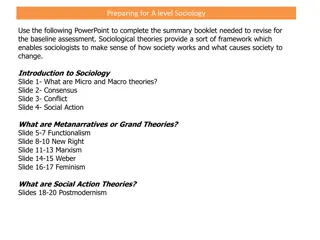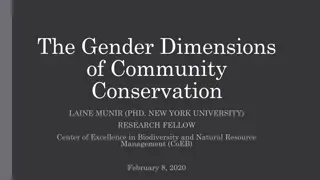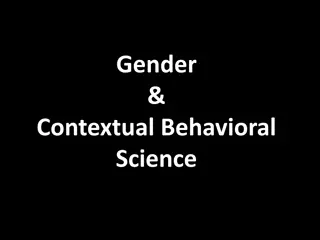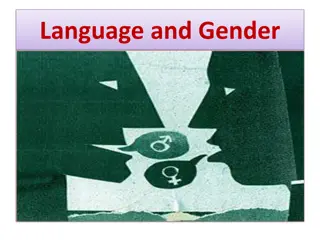Exploring Gender and Language Theories
This content delves into various aspects of gender and language, covering topics such as lexical asymmetry, marked terms, gendered collocations, language features stereotypically associated with women and men, different theoretical models, and the perspectives of notable theorists like Otto Jespersen, Dale Spender, and Deborah Cameron. It also discusses inequality in address terms, critiques on universal terms like 'man', and theories on interruptions in conversations.
Download Presentation

Please find below an Image/Link to download the presentation.
The content on the website is provided AS IS for your information and personal use only. It may not be sold, licensed, or shared on other websites without obtaining consent from the author. Download presentation by click this link. If you encounter any issues during the download, it is possible that the publisher has removed the file from their server.
E N D
Presentation Transcript
1. What is lexical asymmetry? 1 point for definition 1 point for example
1 point for definition 2. What is a marked term? 1 point for example 3. example of gendered collocation Give an
4. Why is there inequality in address terms?
5. What theorist has a problem with the universal term 'man'? Why? A point for each!
6. What are features of women s language (stereotypically)? 7. What are features of male's language (stereotypically)?
7. What did Otto Jespersen say? 8. Why might Jespersen s theory be untrue?
9. Which theorist made her claims in 1975? 10. What did she say? 11. Why might she be incorrect?
12. What is the dominance model? 13. What did Dale Spender say about gender and language?
16. What is the difference model? 17. Which theorist is the most prominent in this model? 18. What did she say about language and gender?
19.What did Zimmerman and west say in 1975? 20.What did Geoffrey Beattie say in response to Zimmerman and West? 21.What did Beattie say about interruptions?
22. What did Deborah Cameron posit in her book "The Myth of Mars and Venus" (2008)
1. What is lexical asymmetry? 1 point for definition 1 point for example
4. Why is there inequality in address terms?
Should it even matter anymore? Asked on a weekly basis. Most forms from loyalty cards to medical questionnaires ask for your title. Female Miss Mrs Ms Male Mr Schwarz (2003) investigates this range of meanings. She identifies the importance society places on marriage for women similarly to other words too! Men don t have to make this choice! For women this indicates marital status, but this is not the case for men. Miss = Unmarried Mrs = Married Ms = ???????
One of Deborah Tannen's most influential ideas is that of the male as norm. Such terms as men , man and mankind may imply this. The term for the species or people in general is the same as that for one sex only. 5. What theorist has a problem with the universal term 'man'? Why? A point for each!
Stereotypical language? What have we got?
Deficit models of language Can you guess what this may mean? This is the theory that the male way of speaking is the normative, and the female departs from the norm. 8. What is the deficit model?
9. What did Otto Jespersen say? 10. Why might Jespersen s theory be untrue?
Otto Jesperson, 1922 women talk a lot women use half-finished sentences because they speak before they have thought about what they will say women link sentences with and because they are emotional rather than grammatical women use adjectives such as pretty and nice too much. They are also fond of saying sopretty and sonice women use adverbs too much and tend towards hyperbole women have a smaller vocabulary than men the words they use are the indispensable small change of a language women know their smaller vocabulary so well that they are more fluent in speaking and less hesitant than men, who are searching for the precise word in their large vocabularies
Otto Jesperson is he for real? novels written by ladies are much easier to read and use fewer difficult words women often gain spoken mastery of foreign languages more easily than men, but when put to the test in translating a difficult text, men prove superior women, by virtue of their sex, "shrank from coarse and gross expressions" women had a "preference for veiled and indirect expressions , which preclude them from being as effective as men. women had a debilitating effect upon the language and it was reasonable for men "certainly with great justice [to] object that there is a danger of the language becoming languid and insipid if we are to content ourselves with women's expressions." men are responsible for introducing new words into the language
11. Which theorist made her claims in 1975? 12. What did she say? 13. Why might she be incorrect?
Robin Lakoff, Deficit Theory, 1975 From Language and Woman s Place, 1975: Speak less frequently Show they are listening by using minimal responses mm, yeah Speak more quietly than men and tend to use the higher pitch range of their voices Use hyper-correct grammar and pronunciation: Standard English and clear enunciation Use a greater range of intonation and speak in italics (emphatic stress): so, very, quite. Use question intonation in declarative statements: women make declarative statements into questions by raising the pitch of their voice at the end of a statement, expressing uncertainty. Use fewer expletives ( Oh dear oh my )
Examples of these linguistic / discursive features. Hedges I d kind of like to , It s sort of , I guess (Super) polite forms I d really appreciate it if.. Tag questions This is nice, isn t it? Speaking in italics Intonational emphasis: So , very etc. Empty adjectives Divine , sweet , charming Hypercorrect grammar and pronunciation More formal enunciation. Lack of a sense of humour Said to be poor joke tellers, and to miss the point Direct quotations Special lexicon Specialised terminology when describing things like colour. E.g. magenta men have more words for sports Question intonation in declarative contexts Seeking approval when making a statement. Uncertain questions as answers. E.g. When will dinner be ready? Around 6 o clock?
Overuse qualifiers: (for example, I thinkthat...) Use super-polite forms: Would you mind... , I'd appreciate it if... , ...if you don't mind . Apologise more: (for instance, I'm sorry, but I think that... ) Use more intensifiers: especially so and very(e.g. I am soglad you came! ) Use more adjectives to describe approximate amounts, around, about.
14. What is the dominance model? 15. What did Dale Spender say about gender and language?
Dominance Theory, Dale Spender 1980 Idea is that men dominate women in language, reflecting a patriarchal society "The crux of our difficulties lies in being able to identify and transform the rules which govern our behaviour and which bring patriarchal order into existence. Yet the tools we have for doing this are part of that patriarchal order. While we can modify, we must none the less use the only language, the only classification scheme which is at our disposal. We must use it in a way that is acceptable and meaningful. But that very language and the conditions for its use in turn structure a patriarchal order."
16. What is the difference model? 17. Which theorist is the most prominent in this model? 18. What did she say about language and gender?
The difference approach: Men and women belong to different sub-cultures and preferences. This approach avoids blaming men for being dominant and avoids suggesting women s speech is inferior.
Deborah Tannen (1990) You Just Don t Understand: Men and Women in Conversation Controversial looked at mixed-gender conversation. She attempts to explain male-female miscommunication by claiming that male-female speech is cross-cultural communication .
Status vs. Support. Men see conversation as a contest, women do not think of the people they converse with as trying to get one up on them . Independence vs. Intimacy. Men see consulting with their partner to be asking for permission rather than simply discussing. Advice vs. Understanding. To many men a complaint is a challenge to come up with a solution, but often women are looking for emotional support, not solutions. Information vs. Feelings. To men, talk is information. It has a practical purpose, and if it does not it s just not worth saying! Orders vs. Proposals Women hedge their orders, Let s . Men can feel that by doing this, a woman is trying to slyly manipulate him to do something rather than just directly ask, like he would. Conflict vs. Compromise. Women are reluctant to openly oppose others How much of this do you agree with? Do we see it happening?
Just to remind you. You absolutely must know these basic theories!!! Lakoff (1975) Language and Women s Place Deficit model. Identified key features of women s talk. Tannen (1990) You Just Don t Understand Difference model. Women and men use language differently. Identified six contrasts. Zimmerman and West (1975) Dominance model. Men interrupt more than women and therefore use talk to dominate. Beattie (1991) Suggested interruptions = interest and aren t gendered. William O Barr and Bowman Atkins (1980) Courtroom studies, using Lakoff and Tannen s findings. Concluded not to do with gender, but to do with power.
19.What did Zimmerman and west say in 1975? 20.What did Geoffrey Beattie say in response to Zimmerman and West? 21.What did Beattie say about interruptions?























